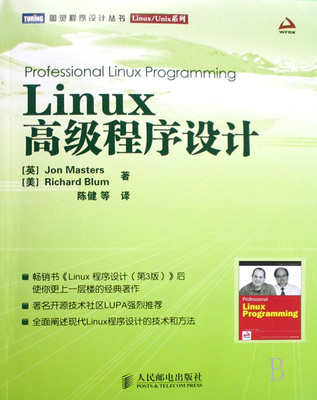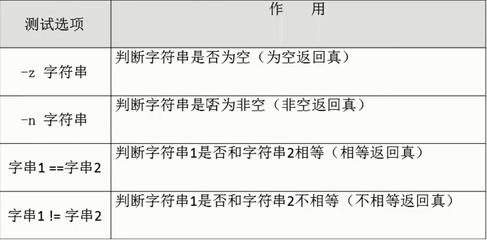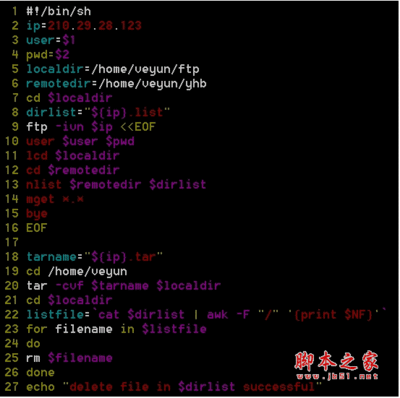if 语句格式
| if 条件 then Command else Command fi别忘了这个结尾 |
| If语句忘了结尾fi test.sh: line 14: syntax error: unexpected end of fi |
if 的三种条件表达式
| if command then if 函数 then | 命令执行成功,等于返回0 (比如grep ,找到匹配) 执行失败,返回非0 (grep,没找到匹配) |
| if [ expression_r_r_r ] then | 表达式结果为真,则返回0,if把0值引向then |
| if test expression_r_r_r then | 表达式结果为假,则返回非0,if把非0值引向then |
[ ]&&——快捷if
| [ -f "/etc/shadow" ] && echo"This computer uses shadow passwors" |
| &&可以理解为then 如果左边的表达式为真则执行右边的语句 |
shell的if与c语言if的功能上的区别
| shell if | c语言if |
| 0为真,走then | 正好相反,非0走then |
| 不支持整数变量直接if 必须:if [ i –ne 0 ] 但支持字符串变量直接if if [ str ] 如果字符串非0 | 支持变量直接if if (i ) |
=================================以command作为if条件===================================
以多条command或者函数作为if 条件
| echo –n “input:” read user if 多条指令,这些命令之间相当于“and”(与) grep $user /etc/passwd>/tmp/null who -u | grep $user then上边的指令都执行成功,返回值$?为0,0为真,运行then echo "$user has logged" else指令执行失败,$?为1,运行else echo "$user has not logged" fi |
| # sh test.sh input : macg macgpts/0May 15 15:55.2075 (192.168.1.100) macg has logged # sh test.sh input : ddd ddd has not logged |
以函数作为if条件(函数就相当于command,函数的优点是其return值可以自定义)
| if 以函数作为if条件, getyn then 函数reture值0为真,走then echo " your answer is yes" else 函数return值非0为假,走else echo "your anser is no" fi |
if command 等价于 command+if$?
| $ vi testsh.sh #!/bin/sh if cat 111-tmp.txt | grepting1 then echo found else echo "no found" fi | $ vi testsh.sh #!/bin/sh cat 111-tmp.txt | grepting1 if [ $? -eq 0 ] then echo $? echo found else echo $? echo "no found" fi |
| $ sh testsh.sh no found | $ sh testsh.sh 1 no found |
| $ vi 111-tmp.txt that is 222file thisting1 is 111file $ sh testsh.sh thisting1 is 111file found | $ vi 111-tmp.txt that is 222file thisting1 is 111file $ sh testsh.sh thisting1 is 111file 0 found |
========================================以条件表达式作为if条件=============================
传统if 从句子——以条件表达式作为 if条件
if [ 条件表达式 ]
then
command
command
command
else
command
command
fi
条件表达式
if [ -f file]如果文件存在
if [ -d...]如果目录存在
if [ -s file]如果文件存在且非空
if [ -r file]如果文件存在且可读
if [ -w file ] 如果文件存在且可写
if [ -x file ] 如果文件存在且可执行
if [ int1 -eq int2]如果int1等于int2
if [ int1 -ne int2] 如果不等于
if [ int1 -ge int2]如果>=
if [ int1 -gt int2]如果>
if [ int1 -le int2]如果<=
if [ int1 -lt int2]如果<
If [ $a = $b] 如果string1等于string2
字符串允许使用赋值号做等号
if [ $string1 != $string2]如果string1不等于string2
if [ -n$string] 如果string 非空(非0),返回0(true)
if [ -z $string]如果string 为空
if [ $sting] 如果string非空,返回0 (和-n类似)
条件表达式引用变量要带$
| if [ a = b ];then echo equal else echo no equal fi |
| [macg@machome ~]$ sh test.sh input a: 5 input b: 5 no equal(等于表达式没比较$a和$b,而是比较和a和b,自然a!=b) |
| if [ $a = $b ];then echo equal else echo no equal fi |
| [macg@machome ~]$ sh test.sh input a: 5 input b: 5 equal |
-eq -ne-lt -nt只能用于整数,不适用于字符串,字符串等于用赋值号=
| [macg@machome ~]$ vi test.sh echo -n "input your choice:" read var if [ $var -eq "yes" ] then echo $var fi [macg@machome ~]$ sh -x test.sh input your choice: y test.sh: line 3: test: y: integerexpression_r_r_r expected 期望整数形式,即-eq不支持字符串 |
=放在别的地方是赋值,放在if [ ]里就是字符串等于,shell里面没有==的,那是c语言的等于
无空格的字符串,可以加" ",也可以不加
| [macg@machome ~]$ vi test.sh echo "input a:" read a echo "input is $a" if [ $a = 123 ] ; then echo equal123 fi |
| [macg@machome ~]$ sh test.sh input a: 123 input is 123 equal123 |
=作为等于时,其两边都必须加空格,否则失效
等号也是操作符,必须和其他变量,关键字,用空格格开 (等号做赋值号时正好相反,两边不能有空格)
| [macg@machome ~]$ vi test.sh echo "input your choice:" read var if [ $var="yes" ] then echo $var echo "input is correct" else echo $var echo "input error" fi | [macg@machome ~]$ vi test.sh echo "input your choice:" read var if [ $var = "yes"] 在等号两边加空格 then echo $var echo "input is correct" else echo $var echo "input error" fi |
| [macg@machome ~]$ sh test.sh input your choice: y y input is correct [macg@machome ~]$ sh test.sh input your choice: n n input is correct 输错了也走then,都走then,为什么? 因为if把$var="yes"连读成一个变量,而此变量为空,返回1,则走else | [macg@machome ~]$ sh test.sh input your choice: y y input error [macg@machome ~]$ sh test.sh input your choice: no no input error 一切正常 |
If[ $ANS]等价于 if [ -n $ANS ]
如果字符串变量非空(then) , 空(else)
| echo "input your choice:" read ANS if [ $ANS ] then echo no empty else echo empth fi |
| [macg@machome ~]$ sh test.sh input yourchoice: 回车 empth说明“回车”就是空串 [macg@machome ~]$ sh test.sh input your choice: 34 no empty |
整数条件表达式,大于,小于,shell里没有> 和<,会被当作尖括号,只有-ge,-gt,-le,lt
| [macg@machome ~]$ vi test.sh echo "input a:" read a if [ $a -ge 100 ] ; then echo 3bit else echo 2bit fi |
| [macg@machome ~]$ sh test.sh input a: 123 3bit [macg@machome ~]$ sh test.sh input a: 20 2bit |
整数操作符号-ge,-gt,-le,-lt, 别忘了加-
| if test $a ge 100 ; then [macg@machome ~]$ sh test.sh test.sh: line 4: test: ge: binary operator expected |
| if test $a -ge 100 ; then [macg@machome ~]$ sh test.sh input a: 123 3bit |
============================逻辑表达式=========================================
逻辑非!条件表达式的相反
if [ ! 表达式 ]
if [ ! -d $num]如果不存在目录$num
逻辑与–a条件表达式的并列
if [ 表达式1 –a 表达式2 ]
逻辑或-o条件表达式的或
if [ 表达式1 –o 表达式2 ]
逻辑表达式
if [ -z "$JHHOME" -a -d $HOME/$num ]
最常见的赋值形式,赋值前对=两边的变量都进行评测
左边测变量是否为空,右边测目录(值)是否存在(值是否有效)
| [macg@mac-home ~]$ vi test.sh : echo "input the num:" read num  echo "input is $num" if [ -z "$JHHOME" -a -d $HOME/$num]如果变量$JHHOME为空,且$HOME/$num目录存在 then JHHOME=$HOME/$num 则赋值 fi echo "JHHOME is$JHHOME" |
| ----------------------- [macg@mac-home ~]$ sh test.sh input the num: ppp input is ppp JHHOME is 目录-d$HOME/$num不存在,所以$JHHOME没被then赋值 |
| [macg@mac-home ~]$ mkdir ppp [macg@mac-home ~]$ sh test.sh input the num: ppp input is ppp JHHOME is /home/macg/ppp |
一个-o的例子,其中却揭示了”=”必须两边留空格的问题
| echo "input your choice:" read ANS if [ $ANS="Yes" -o$ANS="yes" -o $ANS="y" -o $ANS="Y" ] then ANS="y" else ANS="n" fi echo $ANS |
| [macg@machome ~]$ sh test.sh input your choice: n y [macg@machome ~]$ sh test.sh input your choice: no y 为什么输入不是yes,结果仍是y(走then) 因为=被连读了,成了变量$ANS="Yes",而变量又为空,所以走else了 |
| [macg@machome ~]$ vi test.sh echo "input your choice:" read ANS echo"input your choice:" read ANS if [ $ANS = "Yes" -o $ANS ="yes" -o $ANS = "y" -o $ANS = "Y" ] then ANS="y" else ANS="n" fi echo $ANS |
| [macg@machome ~]$ sh test.sh input your choice: no n [macg@machome ~]$ sh test.sh input your choice: yes y [macg@machome ~]$ sh test.sh input your choice: y y |
===================以 test 条件表达式作为if条件===================================
if test $num -eq0等价于 if [ $num –eq 0]
test表达式,没有 [ ]
if test $num -eq0
then
echo "try again"
else
echo "good"
fi
man test
| [macg@machome ~]$ man test [(1)UserCommands[(1) SYNOPSIS test EXPRESSION [ EXPRESSION ] [-n] STRING the length of STRING isnonzero-n和直接$str都是非0条件 -z STRING the length of STRING is zero STRING1 = STRING2 the strings are equal STRING1 != STRING2 the strings are not equal INTEGER1 -eq INTEGER2 INTEGER1 is equal to INTEGER2 INTEGER1 -ge INTEGER2 INTEGER1 is greater than or equal to INTEGER2 INTEGER1 -gt INTEGER2 INTEGER1 is greater than INTEGER2 INTEGER1 -le INTEGER2 INTEGER1 is less than or equal to INTEGER2 INTEGER1 -lt INTEGER2 INTEGER1 is less than INTEGER2 INTEGER1 -ne INTEGER2 INTEGER1 is not equal to INTEGER2 FILE1 -nt FILE2 FILE1 is newer (modification date) than FILE2 FILE1 -ot FILE2 FILE1 is older than FILE2 -b FILE FILE exists and is block special -c FILE FILE exists and is character special -d FILE FILE exists and is a directory -e FILE FILEexists文件存在 -f FILE FILE exists and is a regularfile文件存在且是普通文件 -h FILE FILE exists and is a symbolic link (same as -L) -L FILE FILE exists and is a symbolic link (same as -h) -G FILE FILE exists and is owned by the effective group ID -O FILE FILE exists and is owned by the effective user ID -p FILE FILE exists and is a named pipe -s FILE FILE exists and has a size greater than zero -S FILE FILE exists and is a socket -w FILE FILE exists and is writable -x FILE FILE exists and is executable |
======================if简化语句=================================
最常用的简化if语句
| &&如果是“前面”,则“后面” [ -f /var/run/dhcpd.pid ] && rm/var/run/dhcpd.pid检查 文件是否存在,如果存在就删掉 |
| ||如果不是“前面”,则后面 [ -f /usr/sbin/dhcpd ] || exit0检验文件是否存在,如果存在就退出 |
用简化 if 和$1,$2,$3来检测参数,不合理就调用help
[ -z "$1" ]&&help如果第一个参数不存在(-z 字符串长度为0 )
[ "$1" = "-h" ] &&help如果第一个参数是-h,就显示help
例子
#!/bin/sh
[ -f "/etc/sysconfig/network-scripts/ifcfg-eth0" ]&& rm -f/etc/sysconfig/network-scripts/ifcfg-eth0
cp ifcfg-eth0.bridge/etc/sysconfig/network-scripts/ifcfg-eth0
[ -f "/etc/sysconfig/network-scripts/ifcfg-eth1" ]&& rm -f/etc/sysconfig/network-scripts/ifcfg-eth1
cp ifcfg-eth1.bridge/etc/sysconfig/network-scripts/ifcfg-eth1
[ -f "/etc/sysconfig/network-scripts/ifcfg-eth0:1" ]&& rm -f/etc/sysconfig/network-scripts/ifcfg-eth0:1
 爱华网
爱华网



